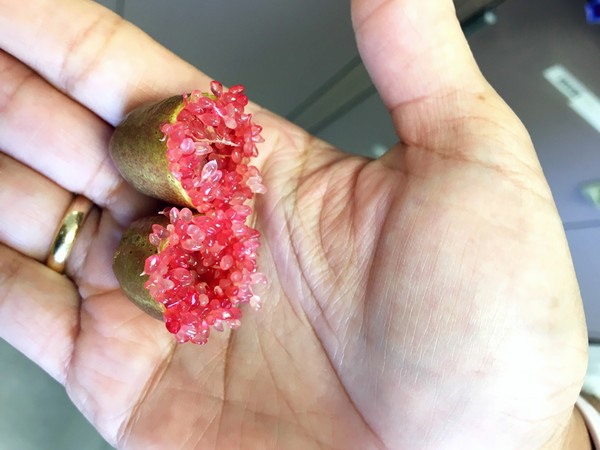Could finger limes be part of the solution in Florida’s struggle with the HLB disease affecting its grapefruit?
Dr. Manjul Dutt thinks possibly so. Dutt, a research assistant scientist in Horticultural Sciences with the University of Florida has been observing finger lime growth in Florida for almost a decade and has made an interesting discovery. “It seemed that when the surrounding trees around the finger lime trees started getting HLB and declining, the finger lime trees continued thriving,” says Dutt. He collected leaf samples from the trees every year to test for HLB, a disease that continues to significantly impact Florida’s citrus crops and the finger lime trees proved tolerant of the disease—unlike other citrus variety trees such as grapefruit, oranges, mandarins and pomelos.
It was then Dutt launched a pilot program with finger lime trees to try integrating the HLB-resistant genes from the finger limes into conventional citrus. “And since then, we’ve generated a large population of trees that we’re evaluating against HLB,” he says.
Why finger limes?
What is it though about finger lime trees that keeps them protected? While there’s no strong evidence pointing in one direction, Dutt has several theories. “We think something could be different in the phloem chemistry. There was earlier work done in collaboration with Dr. Nabil Killiny, looking at the finger lime phytochemicals in the phloem and we found they were quite different from HLB-sensitive cultivars,” he says.

Leaf color could also play a role. “Young leaves in finger limes are always dark red in color. The citrus psyllid move around using visual cues and we think this red color may disorient them and make them less appealing than other citrus which have young green leaves for example,” he says.
Whatever it is, the finger limes at least seem more tolerant—but not 100 percent resistant—to the disease. “If you infect a finger lime tree and a sweet orange tree at the same time and test them a year or two later, you’ll always see the rate of infection is much lower in finger limes than in oranges. There’s something going on in the phloem that we need to understand.”
Tapping into their genetics
While finger limes aren’t exactly set out to be the new crop replacing Florida’s longstanding orange and grapefruit industry, Dutt believes finger lime trees can provide a strong assist. “Hybrids between finger limes and sweet orange down the road may have sweet orange-like traits that can be acceptable to the grower and consumer. It would create a sweet orange-like fruit with finger lime genetics that allow it to be tolerant to HLB,” he says. “Many people in the industry realize it’s a long-term process. Some are skeptical but overall, people are hopeful that the finger-lime genetics play an important role in providing HLB-tolerant trees in the future.”
To date, finger limes are more of a niche crop in North America with only a few growers in California, Hawaii and Florida.
In the meantime, Dutt has produced a finger lime hybrid that looks like a larger finger lime. “We’ll be releasing it this summer—it’s similar to the finger lime but it has more pulp and the same “pearls” that finger limes do,” he says. He adds that it’s a commercial release as a niche crop and hopes the limes will be available in stores in the next three to four years.
For more information:
Dr. Manjul Dutt
University of Florida
Tel: +1 (863) 956-8679
[email protected]
https://crec.ifas.ufl.edu/










